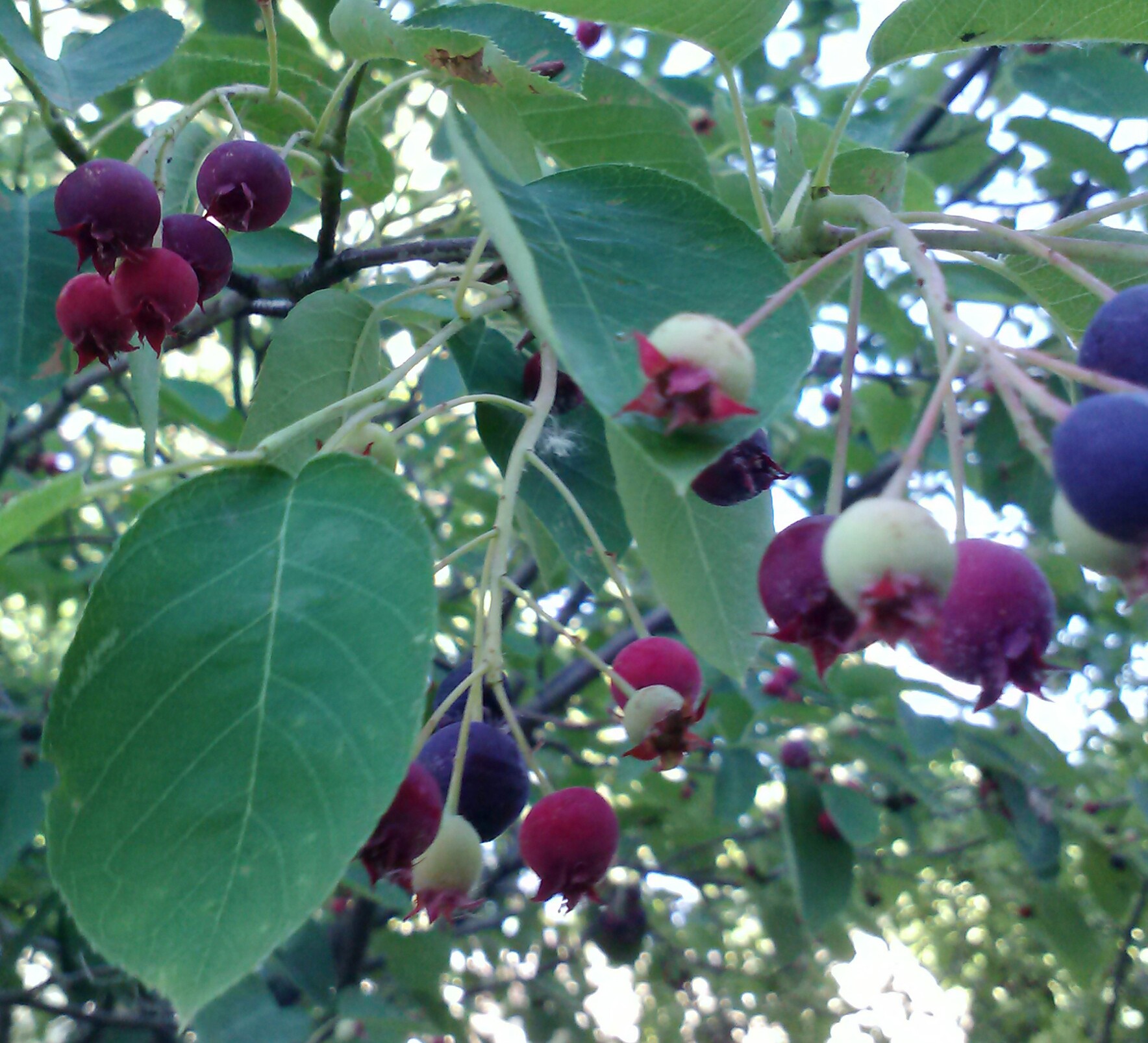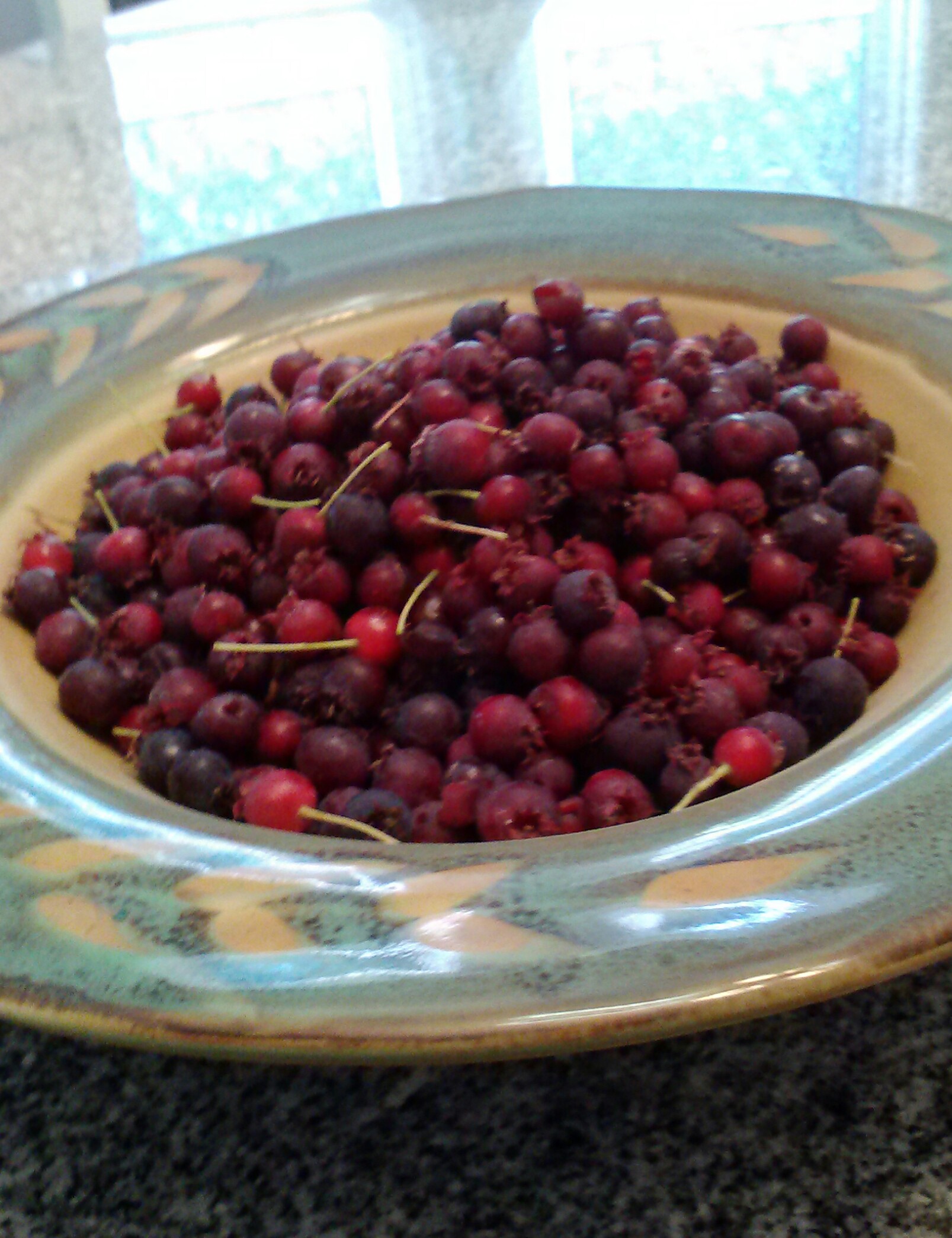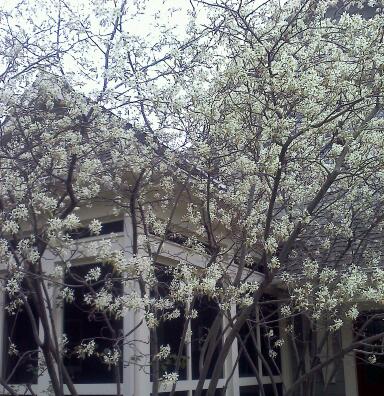by Elsa Johnson
What to Do With Serviceberries:
First, you ask, what do they taste like? To me they taste a bit like cranberries combined with cherries. Above all, somehow, they taste familiar, unlike some of the more exotic fruits currently popular and available – gumi berries, goji berries, honeyberries (which do not taste anything like honey). I like fruit that tastes a bit tart, so I pick my serviceberries when they begin to turn from red to purple. Serviceberries are about the size of currants or small blueberries, so picking is slow – nonetheless, you will soon have enough to brighten something edible. There are small seeds at the top that sometimes pull out as you pick the berries, but often don’t. I find them unobjectionable.
 My multi-trunk serviceberry trees are still relatively small at ten to twelve feet tall. The birds get the berries at the top and on the upper branches, but have a hard time harvesting the berries hanging at the ends of the lower outer branches. Those berries are mine.
My multi-trunk serviceberry trees are still relatively small at ten to twelve feet tall. The birds get the berries at the top and on the upper branches, but have a hard time harvesting the berries hanging at the ends of the lower outer branches. Those berries are mine.
I made buckwheat pancakes with today’s berries, adding some berries directly to the batter while reserving some to make a sauce. I made the sauce by adding the berries to a bit of leftover raspberry/rhubarb jam brightened with lemon juice and cooking briefly (thicken slightly with corn starch if you wish). My spouse and I tend to like things to taste bright rather than merely sweet.
Other things you could do with serviceberries? I think pie made with serviceberries would be good if you had the patience to pick enough berries. The berries hold their shape well even when cooked. The richness of the crust would set off the sweet tartness of the berries. Add a dab of slightly sweetened whipped cream on top — mmmmmm. They would also nicely perk up bran muffins.
Meat eaters might find a relish of serviceberries appealing, particularly with pork or chicken.
In a couple more days the last of the serviceberries will ripen. I think I may try a variation on a dessert from my own Scandinavian background called Rod Grod Med Flod – which, properly pronounced, sounds like you are speaking with a golf ball in your mouth. For my variation of this summer fruit dessert (traditionally made with strawberries or raspberries) I will use homemade small pearl tapioca, the kind where you whip the egg whites to fluff and add them at the last minute to the custard. I like to sweeten my tapioca with honey. I haven’t yet decided whether to turn the berries into the traditional cooked sauce to spoon on top – I think I may just add them whole and raw. I think that might be interesting.
Warning: serviceberries eaten in quantity may be slightly laxative.
Folklore of etymology: Amalanchier is commonly known in various localities as shadblow, serviceberry, juneberry, saskatoon, and other local names, depending on where it grows. Shadblow comes from the Northeast coast where the amalanchiers bloom at the same time the shad (a migratory fish like salmon) ‘blow’ – i.e., swim up river to spawn… while the name Juneberry comes from the tree’s tendency to set fruit in June – it is actually a little late this month.
Wikipedia says: “ …a fanciful etymology explains the name ‘serviceberry’ by noting that the flowers bloom about the time the roads in the Appalachian mountains became passable – allowing circuit riding preachers to resume church services . A similar etymology says that blooming serviceberries indicated the ground had thawed enough to dig graves, so burial services could be held for those who died in the winter when the only way to deal with the bodies was to allow them to freeze and wait for spring.” Wikipedia continues: “Both of these fanciful etymologies are unlikely to be correct since the term is attested for both the English and New World species as early as the 16th century.”
Either way – enjoy your Serviceberries – both for their early spring flowers, so important to early spring pollinators, many of them native, and for the berries that follow in June. Why let the birds and chipmunks have them all?!
It’s Everything
I’m picking serviceberries to the sound
of seeth that sea sound of the wind high
in the rigging of the trees hundreds of
miles from ocean reminding me again
how without water life could not exist
on this planet The sea flows through us all
even though we are far away — through our
salted blood through the birds’ blood (with whom I
share these berries) even through the trees There
are unsalted seas closer home choppy
(and dangerous) that — though good to see to
hear — do not stir the seeth in me I am
picking berries to the sound of sea : three
for the birds two for me Life is good



Life IS good when obsessive/compulsive Cleveland gardeners get to learn more about serviceberries, paw paws, cicadas, Doan Brook restoration projects and all the other great topics that you and the other contributors have posted. Thank you, all!
Great info. Blessed me I reach on your website by accident,
I bookmarked it.